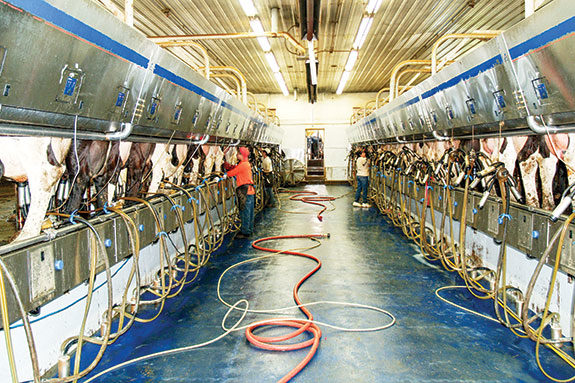Often we hear from a dairy farmer that he has switched liners out due to some issue he is having on his dairy. In many cases, this is the wrong decision, and liner changing is just being used as a Band-Aid solution to some hidden problem.
Liners are one of the easiest things on a dairy farm to change; this can generally be done without changing anything else on the dairy.
Because liners are a consumable product that needs to be changed on a regular basis anyway, it’s the easiest thing to blame. Here are some liner myths and the reasoning given for making a liner switch.
Increased somatic cell counts
Somatic cell counts (SCCs) are one of the most common reasons farmers switch out a liner. When dairy farmers see their SCC increasing, they often assume it is a liner problem – which is hardly ever the case.
A raised SCC comes from many places on a dairy, such as dirty cows, dirty beds, poor management techniques and 100 other different reasons.
Liner design and function is very seldom to blame for a raised SCC; the best thing to do in this type of situation is to get a qualified milk quality expert on the dairy and let the expert help diagnose the problem.
Slips and squawks
Another issue dairymen mistakenly blame on liners is slips and squawks. The likelihood of the slips and squawks coming from the liner decreases the longer the dairy has been using the liner.
The likely culprits of this issue are too low of an average claw vacuum at peak milk flow, poor unit alignment, restrictions in the milk path, loops in the milk path, poor prep and overmilking of the cow at both the start of milking and at the end of milking.
Uneven milking
We often hear from farmers that their liners need to be switched because the cows are not milking out evenly. The first thing a dairyman should do is check that the units are aligned correctly.
Good unit alignment is critical to milking gently, quickly and completely. Good alignment requires ensuring the alignment devices are maintained and used correctly. This will result in better and more complete milk-out of your cows.
Liner ventings
Dairymen regularly ask why a liner needs to be vented; can’t they just drill a hole in the claw? Although this may sound like an easy fix, and possibly a way to save money as non-vented liners are generally cheaper than vented liners, there are several reasons why a liner should be vented.
An air vent is needed in order to create the pressure differential to move milk away from the cow. The vent can be in the claw or the liner milk tube. The advantage of an air vent in the liner milk tube is to get the milk away more quickly from the teat end.
The vent close to the teat end also helps prevent backflush on the teat ends if there is a slip. There are patented jet vents which are smaller on the top and larger on the bottom. If debris gets in the vent, it goes through and doesn’t restrict air flow.
Vents in the liners also get changed regularly versus claws, so producers are assured that the vent is always clean and the correct size.
Vented mouthpiece liner
Perhaps one of the biggest buzzes in the industry is that a dairy needs a vented mouthpiece liner to milk their cows gently. There are many ways to milk cows gently.
The definition of milking a cow gently is to expose her to vacuum for as short of a period of time as possible; a milking unit needs to remove milk gently, quickly and completely.
This is only done by getting the units on in the proper amount of time and getting the unit off as quickly as possible.
Liner design
Liner design also plays an important role in the gentleness of the liner. For example, round liners seal better on the teat barrel, whereas triangular and square liners allow air to bypass around the teat into the mouthpiece.
A vented mouthpiece liner reduces teat rings with square and triangular liners. If teat rings are present with round liners, it’s usually a sign of overmilking.
As the teat loses its seal in the barrel of the liner, the vacuum goes higher in the mouthpiece. Having the units removed at the correct time and not overmilking prevents this from happening and is gentler for the cow.
Liner advice
I would advise anyone who is thinking about switching liners to make sure there is a legitimate reason to be making a switch, such as needing to increase your parlor throughput, wanting to get flow rates up and durations down, and exposing cows to less vacuum.
When it is time to switch, I recommend that you choose a series of liners that allow you to move within the series depending on management style changes and cow behavior.
Select a series of liners with a progression in barrel thickness and mouthpiece thickness to give your dairy a chance to increase the throughput and milkability without switching out liner brands.
The best way to improve parlor performance and improve milkability is to use proper prep procedures with proper lag time before unit attachment, ensure proper pulsation settings, remove units from cows at the right time of milking to ensure an adequate amount of residual milk and choose a liner series that will best meet your dairy’s management style.
At the end of the day, the best thing we can do for our cows is to give them the most consistent milking experience possible; therefore, as dairy farmers you need to make a liner decision based on facts and not perceived advantages. PD
PHOTO
At the end of the day, the best thing that we can do for our cows is to give them the most consistent milking experience possible; therefore, as dairy farmers you need to make a liner decision based on facts and not perceived advantages. Photo by PD staff.

Jason LeGassick
Global Brand Manager Liners
BouMatic








